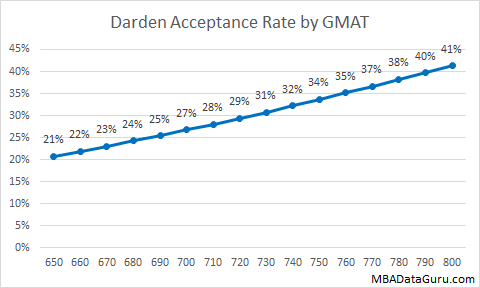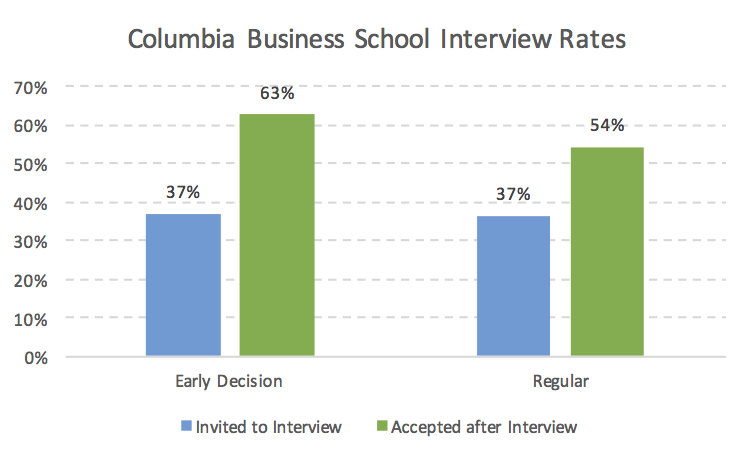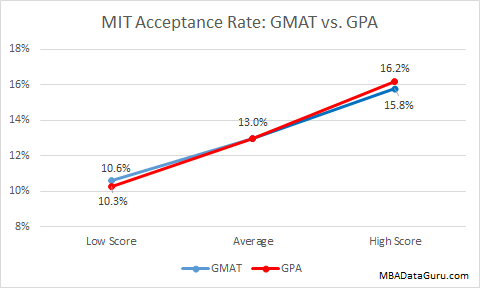Many applicants may wonder if their undergraduate major impacts their chance of getting into business school. Admissions data suggests that your college major can significantly impact your probability of getting into business school. The general trend seems to be that majors that are more dominated by women have a higher acceptance rate while industries that dominated by men had lower acceptance rates. This could be because my data does not have gender as a variable, so I could not account for it. Many people believe that women’s acceptance rate is higher than it is for men with similar credentials, but I have not found any data that proves it. Another explanation is that the female dominated majors are generally underrepresented in business school application pools, so when schools aim to diversify the class, the acceptance rates are higher for those majors. Continue reading
Category Archives: GPA
MBA Interview Probability for top schools by GMAT and GPA
With round 2 application deadlines rapidly approaching, many applicants may wonder what their chance of getting an MBA interview with their favorite schools is. I analyzed the MBA interview probability for the top 25 schools over the past 5 years by GMAT and GPA. Unsurprisingly, for most schools the MBA interview chance increased for high GMAT and high GPA candidates. Continue reading
Military MBA Acceptance Rate Analysis
 Transitioning from the military to MBA is a fairly popular path to follow. A little over 4% of MBA applications come from military veterans. When looking at the data comparing military applicants to traditional MBA applicants, a few trends become clear:
Transitioning from the military to MBA is a fairly popular path to follow. A little over 4% of MBA applications come from military veterans. When looking at the data comparing military applicants to traditional MBA applicants, a few trends become clear:
- Military / Veteran applicants tend to be a year or two older.
- Scores for military applicants are a little lower on average, about 15 points on the GMAT and about .15 for GPA
- Military applicants on average have another year or two of work experience
- Military MBA acceptance rate is about 50% higher than the acceptance rate for traditional applicants
- Some schools have a very large advantage for military applicants while others have little to no advantage
Best Schools for Young MBA Applicants
Deciding when to start applying to business school can be a challenge. Salary increases dramatically after an MBA, but schools tend to prefer applicants with more work experience. I looked at the top 25 US MBA programs’ admission data to find the best schools for young MBA applicants in terms of chance of being admitted. I analyzed the MBA acceptance rate by age to see which schools had the smallest disadvantage for younger applicants relative to traditionally aged MBA applicants. Continue reading
Updated MBA Acceptance Rate by Round
The third round of MBA applications is notorious for having a lower acceptance rate. With the third round application deadlines approaching quickly for most business schools, you may be wondering if the stereotype about the third round is fact or fiction. I updated my analysis of MBA acceptance rate by round with the last 2 years of data and I expanded it to include Olin, Georgetown, USC, Arizona State and Vanderbilt.
This analysis was done using self-reported data from GMAT Club. Data from the class of 2014 through the class of 2018 was used because otherwise there would not be enough data for round 3 and 4 to accurately capture the acceptance rate. Continue reading
Optimal MBA Application Number
Many business school applicants wonder how many MBA applications they should submit? In this article, I will discuss the optimal MBA application number based on real data. Deciding on your MBA application number is challenging because the more schools you apply to, the less time you have to spend on each application. On the other hand, you don’t want to put all of your eggs into one or two baskets. The data suggests that the ideal number of MBA applications is 5 to 7. For more information, check out this article on how to build your portfolio of MBA applications co-authored by Lawrence Linker and I. Continue reading
Strategies on Building Your MBA Application Portfolio
As Founder and Application Coordinator for MBA Link, one of the first things I’m often consulted on is how many schools an applicant should apply to and which ones. This is an extremely important step to get right in the application process, because there is almost no other decision you will make along the way that has a greater influence on how likely it is you will end up getting into a school with which you will be happy. Continue reading
Low GPA MBA Acceptance Rate Analysis
Many applicants worry about applying to business school if they have a low GPA. I analyzed the low GPA MBA acceptance rate at the top 25 schools to see what are the realistic chances for applicants with a GPA below 3.0. In my data sample from GMAT Club, less than 3% of applicants had a low GPA, which I defined as below 3.0. Individual schools did not have enough data for me to analyze in depth, so I grouped schools into clusters for analysis. I was surprised to see that low GPA MBA acceptance rate is a lot higher than I expected. Continue reading
UNC MBA Acceptance Rate Analysis
Kenan-Flagler is University of North Carolina’s business school. UNC has five programs including a full-time MBA, various executive MBAs and an online MBA program. UNC’s MBA program is currently ranked 18th by US News and World Report. The UNC MBA class of 2017 has an average GMAT of 710 and GPA of 3.4. I built a logistic regression to predict an applicant’s chance of admission to UNC, here are the insights I gained from it. Continue reading
Stanford MBA Acceptance Rate Analysis
When I first built the Stanford MBA acceptance rate model, it showed that GPA had little to no impact on acceptance rate. I have reevaluated the data and now I believe that GPA does matter when applying to Stanford. Although GPA has an impact on acceptance, GMAT is still more important for Stanford MBA admissions. Continue reading
MBA Acceptance Rate by Country
Most elite American business schools brag about how internationally diverse they are. Although American business schools try to make sure they have students from all over the world, the reality is that there are winners and losers. Applicants from some countries have an easier time than others. In this analysis I calculated the MBA acceptance rate by country and region for American MBA programs. Continue reading
McCombs Acceptance Rate Analysis
McCombs School of Business is a top MBA program and part of University of Texas Austin. The full-time program is small; the class of 2017 is 267 students. McCombs average GMAT is 694 and average GPA 3.40. The acceptance rate is at the higher end of the spectrum at 35%. UT Austin also has an evening business school with more relaxed admissions criteria. For the evening MBA, GMAT is 640 and GPA is 3.34. Continue reading
Yale MBA Acceptance Rate Analysis
Yale School of Management, also known as YSOM, is a prestigious school located in New Haven, Connecticut. It is difficult to gain admission to Yale’s MBA program, similar to their undergraduate school. The YSOM class of 2016 has impressive statistics, with a median GMAT of 720 and median GPA of 3.56. Only 22% of applicants who apply to Yale will be accepted. Continue reading
Darden MBA Acceptance Rate Analysis
Darden, UVA’s business school, is the business school ranked 11th in the US. Darden is a prestigious school and only 25% of applicants are accepted. I built a predictive model to see which factors are most and least important for Darden admission, the results may surprise you.
Darden MBA Acceptance Rate by GMAT
It is not shocking that increasing your GMAT will raise your Darden admission chance. The average GMAT score for accepted students at UVA’s business school is 706. If you were to increase your GMAT by 100 points from 650 to 750 when applying to Darden, you would raise your acceptance rate by an impressive 62%. Even at a GMAT score of 650, chance of acceptance is still over 20%.
Darden MBA Acceptance Rate by GPA
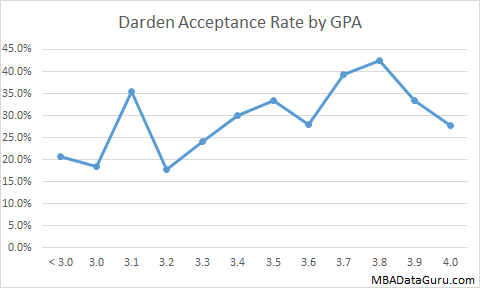 Shockingly, GPA has little to no impact on your chance of admission to Darden. The average GPA of accepted students is 3.52. When I ran a regression model on factors that predict the chance of acceptance at Darden, GPA was one of the first variable eliminated. The graph above confirms my conclusion, a person with a 4.0 GPA has only a slightly higher chance of admission than a person with a 3.0. If you have a low GPA and a high GMAT, then Darden is a great school for you.
Shockingly, GPA has little to no impact on your chance of admission to Darden. The average GPA of accepted students is 3.52. When I ran a regression model on factors that predict the chance of acceptance at Darden, GPA was one of the first variable eliminated. The graph above confirms my conclusion, a person with a 4.0 GPA has only a slightly higher chance of admission than a person with a 3.0. If you have a low GPA and a high GMAT, then Darden is a great school for you.
Darden MBA Acceptance Rate by Round
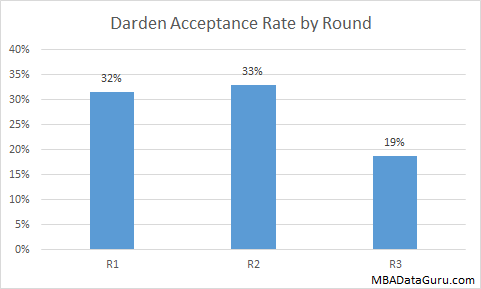
Recently I performed an analysis of MBA acceptance rates by application round. The Darden MBA acceptance rate was noticeably lower during round 3. When building the Darden predictive model I confirmed that the low round 3 acceptance rate was in fact statistically significant. Although round 3 applicants still have a fairly reasonable 19% acceptance rate, it is still significantly lower than the round 1 and 2 Darden admission rates. If you are on the fence about applying round 3 to Darden, you might as well wait for next year.
Other Darden MBA Acceptance Rate Factors
Similar to Wharton, Darden MBA applicants from India have roughly a 75% lower chance of admission. Computer science majors also have a similarly low chance of being accepted, coming in at 11%.
Tuck Acceptance Rate Analysis
Tuck School of Business is a top MBA program with a competitive admissions process. The Tuck acceptance rate is low, at 20%. Unlike most other top MBA programs, Tuck is a self initiated interview. Anyone who visits campus can schedule an interview. In this article I will discuss which factors impact Tuck acceptance rate.
Tuck Acceptance Rate by GMAT
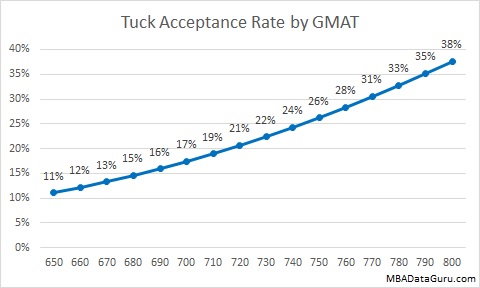 GMAT score has a large influence on Tuck acceptance rate. The average Tuck GMAT score is fairly high at 716. Adding a hundred points to your GMAT more than doubles your chance of admission. Even with a low GMAT of 650, acceptance rate at Dartmouth is still more than 10%, unlike Harvard where you need a 740 to have a 10% chance of admission.
GMAT score has a large influence on Tuck acceptance rate. The average Tuck GMAT score is fairly high at 716. Adding a hundred points to your GMAT more than doubles your chance of admission. Even with a low GMAT of 650, acceptance rate at Dartmouth is still more than 10%, unlike Harvard where you need a 740 to have a 10% chance of admission.
Tuck Acceptance Rate by GPA
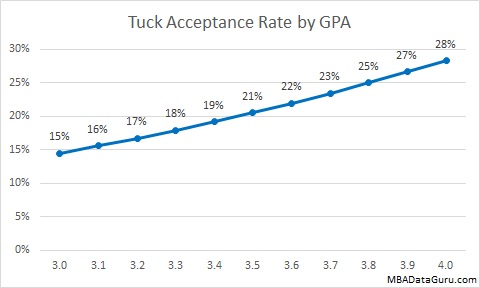 The average Tuck GPA is a solid 3.5. It is clear that applicants with a higher GPA have a better chance of being accepted. Once graduated, GPA is set in stone, so you might as well focus on increasing your GMAT which can still be increased.
The average Tuck GPA is a solid 3.5. It is clear that applicants with a higher GPA have a better chance of being accepted. Once graduated, GPA is set in stone, so you might as well focus on increasing your GMAT which can still be increased.
Tuck GMAT vs. GPA
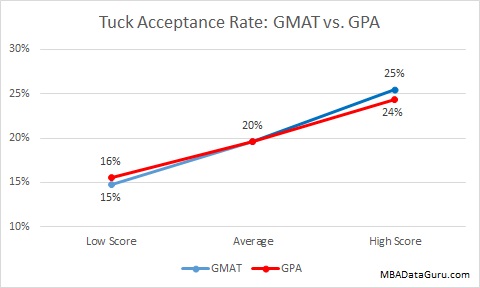 Next we look at whether Tuck prefers a high GMAT or a high GPA. The graph above shows that applicants with a high GMAT have a slightly better chance of being admitted than an applicant with a high GPA. The difference is so small that it is not very important.
Next we look at whether Tuck prefers a high GMAT or a high GPA. The graph above shows that applicants with a high GMAT have a slightly better chance of being admitted than an applicant with a high GPA. The difference is so small that it is not very important.
Tuck Acceptance Rate by Application Round
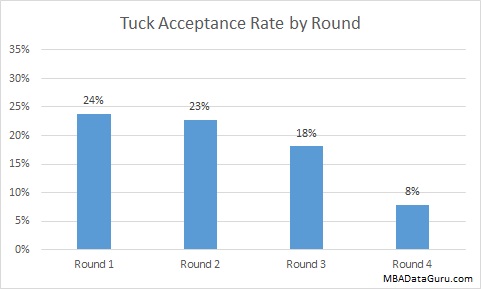 As you can see in the graph above, the round you apply to Tuck does influence acceptance rate significantly. Round 1 and 2 have a similar admission rates of around 24%. Round 3 acceptance rate starts to drop off noticeably to 18% but not much below the 20% average acceptance rate. The Tuck acceptance rate for round 4 is extremely low, at 8%. Unless you have an incredible application or are desperate to leave your current job for business school, I recommend avoiding round 4 and waiting for the next year.
As you can see in the graph above, the round you apply to Tuck does influence acceptance rate significantly. Round 1 and 2 have a similar admission rates of around 24%. Round 3 acceptance rate starts to drop off noticeably to 18% but not much below the 20% average acceptance rate. The Tuck acceptance rate for round 4 is extremely low, at 8%. Unless you have an incredible application or are desperate to leave your current job for business school, I recommend avoiding round 4 and waiting for the next year.
Tuck Acceptance Rate by Years of Work Experience
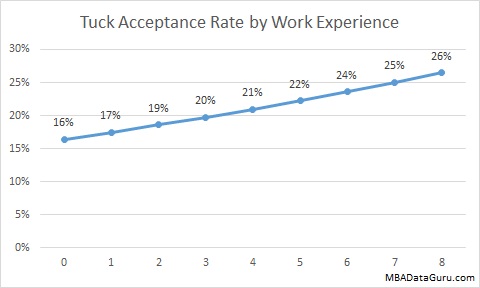 Tuck values applicants that have a longer work experience. Each year of work experience raises your chance of admission by a little more than 1%.
Tuck values applicants that have a longer work experience. Each year of work experience raises your chance of admission by a little more than 1%.
Tuck Acceptance Rate by Age
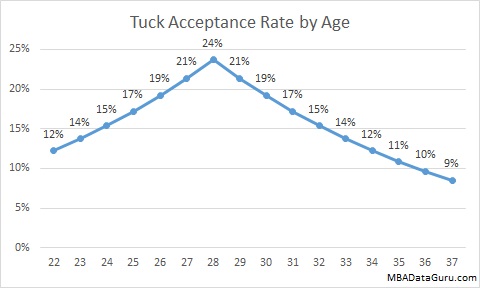 Similar to other schools such as Columbia, Duke, Cornell and Booth, Tuck prefers applicants who are around 28 years old. I believe that this is because they have enough work experience to draw on during school but are not too old to be placed at companies during recruiting. In the above graphs I look at age and years of work experience separately, however in reality they are closely related.
Similar to other schools such as Columbia, Duke, Cornell and Booth, Tuck prefers applicants who are around 28 years old. I believe that this is because they have enough work experience to draw on during school but are not too old to be placed at companies during recruiting. In the above graphs I look at age and years of work experience separately, however in reality they are closely related.
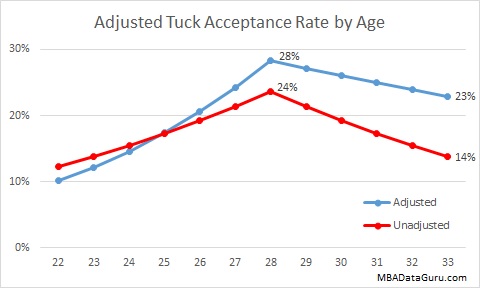 In the graph above I adjusted the original acceptance rate by age graph and added in the impact of work experience. For simplicity I assume that everyone graduates at 22 and works full time from graduation until they apply for business school. When these two factors are combined, you see that older applicants have a large advantage compared to younger applicants.
In the graph above I adjusted the original acceptance rate by age graph and added in the impact of work experience. For simplicity I assume that everyone graduates at 22 and works full time from graduation until they apply for business school. When these two factors are combined, you see that older applicants have a large advantage compared to younger applicants.
Other Tuck Admissions Factors
There are a few other factors that affect your chance of admission to Tuck. International applicants (excluding India) have a significantly higher chance of admission, at 28% acceptance rate. Applicants that worked in Venture Capital are especially prized at Tuck, with an impressive 47% chance of admission.
If you are thinking of applying to Tuck, be sure to check out my Tuck Interview Question Guide so you know what questions to expect. The data for this analysis came from GMAT Club.
Columbia MBA Acceptance Rate Analysis
The Columbia MBA acceptance rate is on the higher side for a top 10 school, at around 18%. Despite the deceptively high acceptance rate, Columbia is still a tough school to gain admission. I built a predictive model which can give you some insight into what the Columbia Business School admissions committee is looking for in applicants.
Columbia MBA Acceptance Rate by GMAT
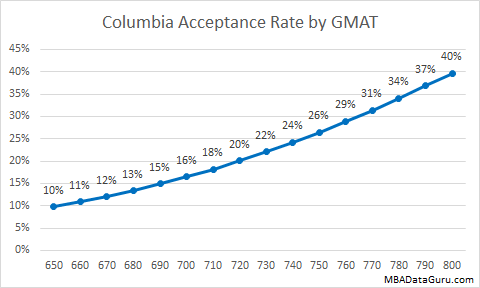 As expected, Columbia MBA acceptance rate increases as GMAT rises. The average GMAT score is an impressive 719. Increasing GMAT score by 100 points from 650 to 750 increases odds of acceptance by 140%, which is a bigger benefit than MIT.
As expected, Columbia MBA acceptance rate increases as GMAT rises. The average GMAT score is an impressive 719. Increasing GMAT score by 100 points from 650 to 750 increases odds of acceptance by 140%, which is a bigger benefit than MIT.
Columbia MBA Acceptance Rate by GPA
Surprisingly GPA has little to no affect on acceptance rate at Columbia. The average GPA of Columbia applicants is 3.49 while the GPA for those admitted is almost unchanged at 3.51. Stanford is the only other school where GPA doesn’t matter. For those of you out there with a low GPA and high GMAT, Columbia is a great school to apply.
Columbia MBA Acceptance Rate by Round
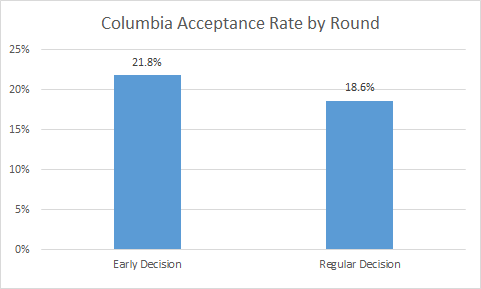 The round you apply in impacts Columbia MBA acceptance rate. At CBS, if you apply during Early Decision then you are forced to enroll if accepted. Columbia seems to be worried about yield for accepted students if they are forcing applicants to choose them. If you are serious about Columbia then consider applying Early Decision because you have a slight edge otherwise you might as well wait for regular decision. Columbia is actually rolling admissions, so the sooner you submit your app the faster you get your decision.
The round you apply in impacts Columbia MBA acceptance rate. At CBS, if you apply during Early Decision then you are forced to enroll if accepted. Columbia seems to be worried about yield for accepted students if they are forcing applicants to choose them. If you are serious about Columbia then consider applying Early Decision because you have a slight edge otherwise you might as well wait for regular decision. Columbia is actually rolling admissions, so the sooner you submit your app the faster you get your decision.
Columbia MBA Acceptance Rate by Age
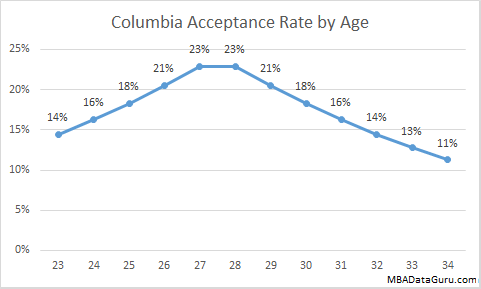 The age at which you apply has a strong impact on your chance of admission. The best time to apply is when you are 27 or 28. The further a candidate is from the average age, the lower their chance of acceptance is. I believe that this is because candidates with around 5 years of work experience have worked long enough to impress potential employers and contribute to classroom discussion while not being over qualified for on campus recruiting positions. Duke, Cornell and Booth all have a similar age effect.
The age at which you apply has a strong impact on your chance of admission. The best time to apply is when you are 27 or 28. The further a candidate is from the average age, the lower their chance of acceptance is. I believe that this is because candidates with around 5 years of work experience have worked long enough to impress potential employers and contribute to classroom discussion while not being over qualified for on campus recruiting positions. Duke, Cornell and Booth all have a similar age effect.
Other Admissions Factors
Liberal arts majors have roughly twice the acceptance rate as others. I don’t have gender in my data set but my hypothesis is that Columbia is trying to attract women which is why the acceptance rate is so high for liberal arts majors. Acceptance rate is higher for economics majors but lower for finance majors. Consultants also have a major advantage, with an impressive 30% acceptance rate.
Columbia MBA Acceptance Rate by GPA
I updated this article by request to show how Columbia acceptance rate changes by GPA. In the chart below you can see that from 3.0 to 4.0 the acceptance rate stays fairly stable, slightly above 20% for all GPAs other than 3.2 and 3.9. Shockingly the acceptance rate at 3.0 is actually higher than 4.0.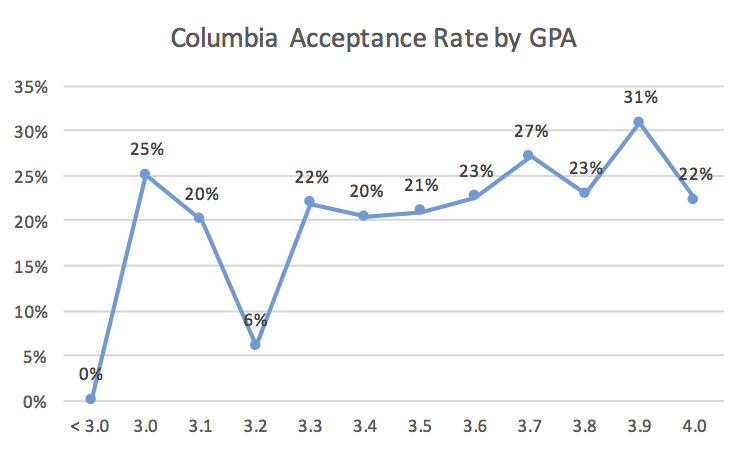
CBS Interview Invite Rate and Acceptance Rate by Round
A reader asked me how applying early vs. regular affected an applicants chance of being invited to interview and accepted after interview. It looks like applying early does not improve an applicant’s chance of being interviewed but does raise the acceptance rate if invited to interview. Approximately 40% of applicants apply through early decision.
The data for this post comes from GMAT Club.
MIT MBA Acceptance Rate Analysis
MIT is one of the most selective business schools in the top ten after Stanford and Harvard. The MIT MBA acceptance rate is only 13%, however several factors can influence your chance of admission at Sloan. Now that I have finished my consulting interviews and secured some summer internship offers I have been able to turn my focus back to this website. I built a statistic model to predict the chance of admissions based on a few pieces of data. I plan to build an admissions calculator, but until then I’ll share with you some of the insights I learned about MIT MBA acceptance rate.
MIT MBA Acceptance Rate by GMAT
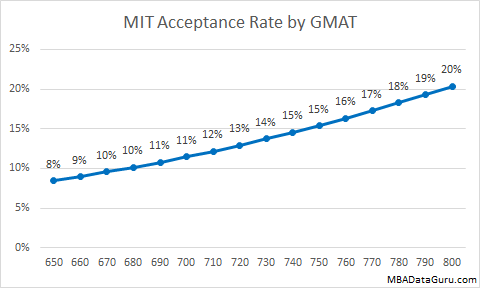 As you would expect, a higher GMAT increases your chance of acceptance at MIT. The average GMAT score at MIT is 713, which results in a 13% acceptance rate. Increasing your GMAT by 100 points from 650 to 750 would roughly double your chance of admission. Even with an 800, the acceptance rate is only 20%.
As you would expect, a higher GMAT increases your chance of acceptance at MIT. The average GMAT score at MIT is 713, which results in a 13% acceptance rate. Increasing your GMAT by 100 points from 650 to 750 would roughly double your chance of admission. Even with an 800, the acceptance rate is only 20%.
MIT MBA Acceptance Rate by GPA
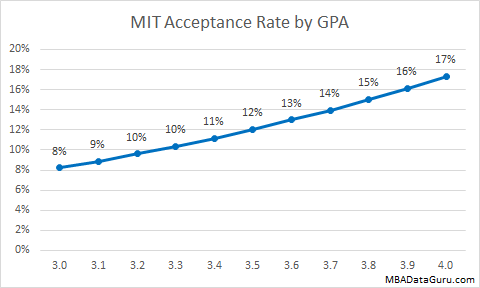 GPA is also critical for admission into the Sloan School of Management. The average GPA is very high at 3.6. For each .10 change in GPA, the acceptance rate changes by roughly 1%. Obviously your GPA is likely already written in stone, so you should focus on increasing your GMAT instead.
GPA is also critical for admission into the Sloan School of Management. The average GPA is very high at 3.6. For each .10 change in GPA, the acceptance rate changes by roughly 1%. Obviously your GPA is likely already written in stone, so you should focus on increasing your GMAT instead.
MIT MBA Acceptance Rate: GMAT vs. GPA
Most schools prefer a high GMAT score* to a high GPA, however MIT is not one of them. The only other school that prefers a high GPA is Harvard Business School. Although GPA matters slightly more than GMAT, GPA can’t be changed once you graduate. If you have a low GPA then make sure you have a solid GMAT and focus on other factors like leadership and volunteer work. I started a networking group that grew to 900 people, which went over well with the admissions committee. It wasn’t even hard, I just started a meetup group in my area.
MIT MBA Acceptance Rate by Round
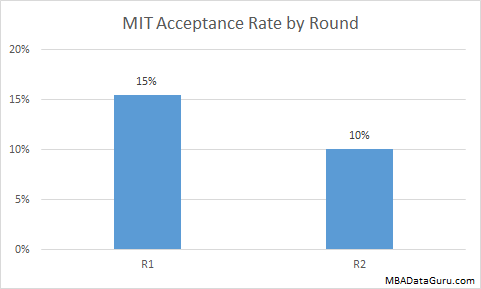 At Sloan, the round you apply in is very important. As you can see in the graph above, acceptance rate at MIT is 50% higher for round 1 applicants compared to round 2. If you have no other choice, you might as well apply round 2, but absolutely try to apply round 1 if possible.
At Sloan, the round you apply in is very important. As you can see in the graph above, acceptance rate at MIT is 50% higher for round 1 applicants compared to round 2. If you have no other choice, you might as well apply round 2, but absolutely try to apply round 1 if possible.
GMAT, GPA and application round were the only factors that had a noticeable affect on admissions rate. Surprisingly, industry, major and years or work experience had no impact on acceptance rate.
*A high GMAT or high GPA is defined as one standard deviation above average.
Booth Admissions Rate Analysis
University of Chicago is a fairly selective business school with an acceptance rate of 22%. Similar to Kellogg, Booth has one of the higher acceptance rates for a top 10 school. While building an MBA admission calculator, I uncovered some insights on how Booth evaluates MBA applicants.
Booth Admissions Rate by GMAT
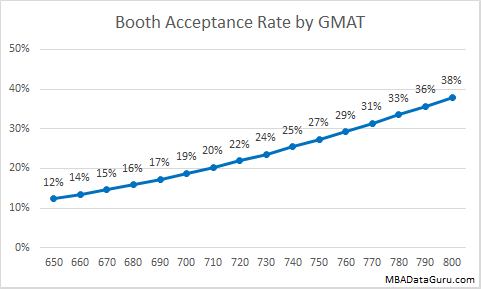 The graph above demonstrates that GMAT has a high impact on Booth admissions. Increasing your GMAT from 650 to 750 more than doubles your chance of admission. The average GMAT score for an applicant is 718, but the admitted applicants have a slightly higher GMAT of 724.
The graph above demonstrates that GMAT has a high impact on Booth admissions. Increasing your GMAT from 650 to 750 more than doubles your chance of admission. The average GMAT score for an applicant is 718, but the admitted applicants have a slightly higher GMAT of 724.
Booth Admissions Rate by GPA
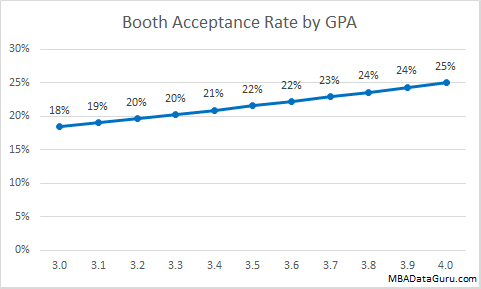 A high GPA will give you a slightly higher acceptance rate at University of Chicago, but it is easy to see that GPA doesn’t have a very large impact on admission rate. Even with a 3.0 GPA the Booth acceptance rate is 18% which is higher than the acceptance rate at Harvard for an applicant with a 4.0.
A high GPA will give you a slightly higher acceptance rate at University of Chicago, but it is easy to see that GPA doesn’t have a very large impact on admission rate. Even with a 3.0 GPA the Booth acceptance rate is 18% which is higher than the acceptance rate at Harvard for an applicant with a 4.0.
Booth Acceptance Rate GMAT vs. GPA
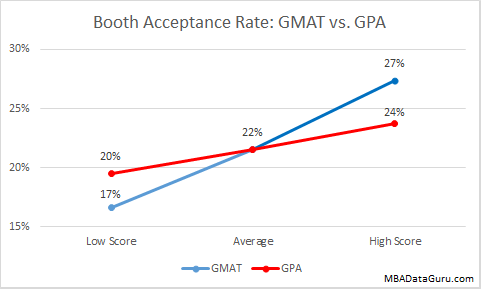 The graph above compares the importance of GMAT vs. GPA to Booth admissions. Candidates with a high GMAT score had a significantly higher acceptance rate than those who had a high GPA.* If you have a high GMAT and a low GPA, University of Chicago is an ideal school at which to apply. For example an applicant with 3.0 GPA and a 760 GMAT has a 25% chance of being admitted.
The graph above compares the importance of GMAT vs. GPA to Booth admissions. Candidates with a high GMAT score had a significantly higher acceptance rate than those who had a high GPA.* If you have a high GMAT and a low GPA, University of Chicago is an ideal school at which to apply. For example an applicant with 3.0 GPA and a 760 GMAT has a 25% chance of being admitted.
Booth Admission Rate by Age
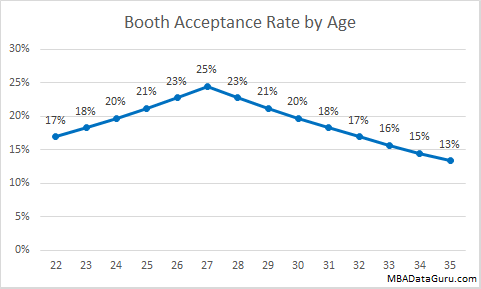 Similar to Duke and Cornell, the Booth admission committee prefers applicants who are around 27. The further a candidate is from the average age, the lower their chance of acceptance is. I believe that this is because candidates with around 5 years of work experience have worked long enough to impress potential employers and contribute to classroom discussion while not being over qualified for on campus recruiting positions.
Similar to Duke and Cornell, the Booth admission committee prefers applicants who are around 27. The further a candidate is from the average age, the lower their chance of acceptance is. I believe that this is because candidates with around 5 years of work experience have worked long enough to impress potential employers and contribute to classroom discussion while not being over qualified for on campus recruiting positions.
Booth Admissions Rate by Round
 Which round you apply in does actually affect your chance of admission at University of Chicago. There is a small drop off in acceptance rate between round 1 and 2, but then a large drop in round 3.
Which round you apply in does actually affect your chance of admission at University of Chicago. There is a small drop off in acceptance rate between round 1 and 2, but then a large drop in round 3.
Other Factors that Impact Booth Acceptance Rate
Applicants who are living in India have only a 7% chance of being accepted at Booth. Science and Math majors have a slightly higher chance of admission. Liberal Arts and Humanities majors have an exceptionally high chance of being accepted, at 56%, while Engineering majors have lower odds at 17%. I think that it is not that Booth is specifically trying to attract Liberal Arts majors, but that they are trying to bring in more women, who happen to be more likely to major in Liberal Arts. Finally investment bankers have only a 14% acceptance rate at Booth.
*A high GMAT or high GPA is defined as one standard deviation above average.
Duke MBA Acceptance Rate Analysis
Duke’s Fuqua School of Business is one of the top 20 MBA programs in the US. The Duke MBA acceptance rate is 25%, which makes being admitted a big accomplishment. The next question is obviously what characteristics does the Duke admissions committee look for in Fuqua applicants? Not only are GMAT and GPA important factors that will impact your admissions, but also your age and the round you apply in affect your chance of acceptance.
Duke MBA Acceptance Rate by GMAT
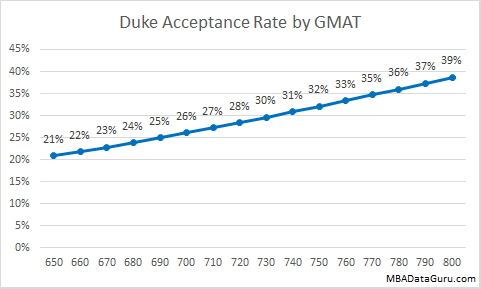 The average Duke applicant has a GMAT of 690, several points lower than the 697 for accepted candidates. As expected the acceptance rate increases as an applicants GMAT rises. The graph above shows Duke MBA acceptance rate by GMAT for the average applicant with a GPA of 3.35.
The average Duke applicant has a GMAT of 690, several points lower than the 697 for accepted candidates. As expected the acceptance rate increases as an applicants GMAT rises. The graph above shows Duke MBA acceptance rate by GMAT for the average applicant with a GPA of 3.35.
Duke MBA Acceptance Rate by GPA
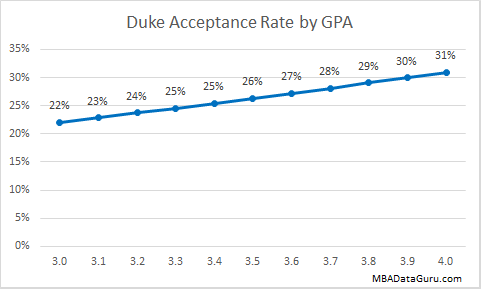 Unlike schools such as Stanford and Cornell, GPA does affect Duke MBA acceptance rate. The average applicant has a GPA of 3.35, however accepted applicant’s GPA is slightly higher. Above you can see the admission rate by GPA at Fuqua.
Unlike schools such as Stanford and Cornell, GPA does affect Duke MBA acceptance rate. The average applicant has a GPA of 3.35, however accepted applicant’s GPA is slightly higher. Above you can see the admission rate by GPA at Fuqua.
Duke MBA Acceptance Rate GMAT vs. GPA
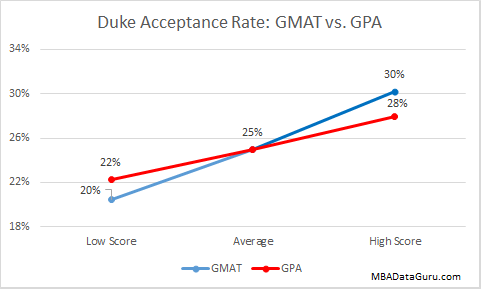 Now that you know that GMAT and GPA both matter to Duke, the next question is which is more important. My admissions analysis shows that Duke prefers GMAT over GPA*. A high score on the GMAT will increase Duke MBA acceptance rate from 25% to 30%. However, a high GPA only increases your chance of admission at Duke to 28%. For applicants with a high GMAT and low GPA, Duke is a good school at which to apply. For example an applicant with a 750 GMAT and 3.0 GPA has a 29% chance of getting into Duke.
Now that you know that GMAT and GPA both matter to Duke, the next question is which is more important. My admissions analysis shows that Duke prefers GMAT over GPA*. A high score on the GMAT will increase Duke MBA acceptance rate from 25% to 30%. However, a high GPA only increases your chance of admission at Duke to 28%. For applicants with a high GMAT and low GPA, Duke is a good school at which to apply. For example an applicant with a 750 GMAT and 3.0 GPA has a 29% chance of getting into Duke.
Duke MBA Acceptance Rate by Age
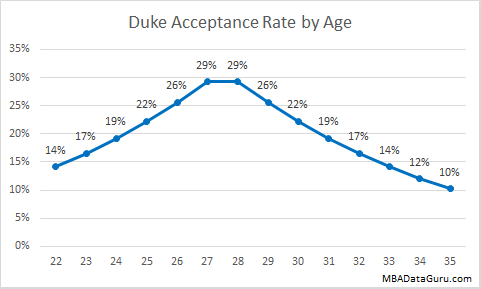 Similar to other schools such as Stern, age impacts acceptance rate. Applicants who are around 27 to 28 have the highest chance of being accepted at Duke, while older and younger candidates have lower odds of being admitted. My hypothesis is that younger applicants don’t bring as much work experience to the class room discussion while older applicants are hard to place at top companies during on campus recruiting.
Similar to other schools such as Stern, age impacts acceptance rate. Applicants who are around 27 to 28 have the highest chance of being accepted at Duke, while older and younger candidates have lower odds of being admitted. My hypothesis is that younger applicants don’t bring as much work experience to the class room discussion while older applicants are hard to place at top companies during on campus recruiting.
Duke MBA Acceptance Rate by Round
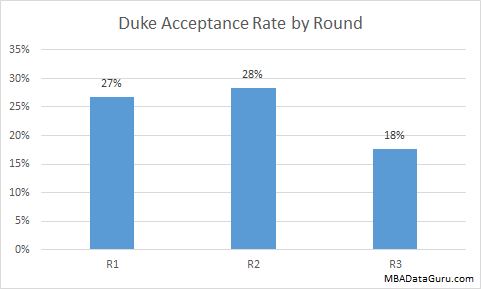 I looked into how application round affected your chance of admission at Duke, and it was not statistically significant. Even the low round 3 acceptance rate cannot be confirmed as accurate because of low volume. Don’t worry too much about applying first or second round, but you may want to avoid round 3 just to be safe.
I looked into how application round affected your chance of admission at Duke, and it was not statistically significant. Even the low round 3 acceptance rate cannot be confirmed as accurate because of low volume. Don’t worry too much about applying first or second round, but you may want to avoid round 3 just to be safe.
Other Factors Affecting Acceptance Rate
People applying from India had a significantly lower chance of admissions, while applicants from the US had a higher acceptance rate at Duke. Applicants who majored in business had a slightly lower admission rate. Military applicants had an astonishingly high acceptance rate of 50%. So all you veterans out there should strongly consider applying to Duke.
The data used for this analysis comes from GMAT Club.
*For GMAT vs. GPA comparison a high score is defined by one standard deviation above the average GMAT or GPA.
Cornell MBA Acceptance Rate Analysis
Many MBA applicants wonder what their chances of getting into a top school is. This analysis looks at Cornell MBA acceptance rate based on data such as GMAT, GPA, undergraduate major, and age at application. The average acceptance rate at Cornell’s Johnson Graduate School of Management is 22%, which is higher than all of the schools in the top 10 but lower than many of the schools ranked 11 to 20.
Cornell MBA Acceptance Rate by GMAT
 As you would expect, GMAT has a high impact on Cornell MBA acceptance rate. The average GMAT for the Cornell MBA class of 2016 is 700. Although GMAT does affect Cornell MBA acceptance rate, GMAT has a smaller importance than other schools such as Kellogg. Increasing your GMAT score by 30 points raises your chance of admission by 5% at Kellogg but only by 2% at Cornell.
As you would expect, GMAT has a high impact on Cornell MBA acceptance rate. The average GMAT for the Cornell MBA class of 2016 is 700. Although GMAT does affect Cornell MBA acceptance rate, GMAT has a smaller importance than other schools such as Kellogg. Increasing your GMAT score by 30 points raises your chance of admission by 5% at Kellogg but only by 2% at Cornell.
Cornell MBA Acceptance Rate by GPA
Strangely enough it appears that GPA has little to no impact on your acceptance rate at Johnson. When I ran the logistic regression, GPA was the first variable I eliminated. Even at Stanford, GPA wasn’t eliminated until almost at the end. This suggests to me that Cornell really doesn’t care about GPA. If you have a low GPA and a high GMAT, then you should be applying to Cornell for the highest chance of admission. The average GPA from my data set, which came from GMAT Club, was 3.40 for both accepted and for declined applicants.
Cornell MBA Acceptance Rate by Age
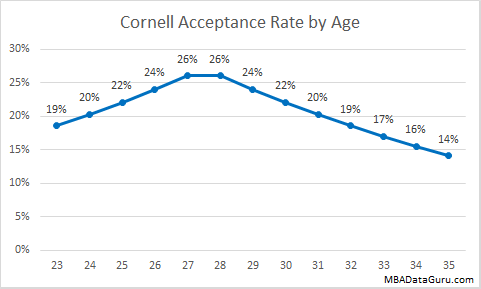 Although your GPA doesn’t matter to Cornell, the age at which you apply does matter. Similar to other schools, such as NYU, the age at which you apply does impact your chance of admission. Cornell prefers candidates who are close to the average age of around 27 or 28. The further you deviate from this average age, the lower your chances of admission are. I believe that the schools do this for two reasons. The first is that young people don’t have as much work experience, so they tend to have less to contribute to the conversation in class. At the other end, candidates that are too old are harder to place in recruiting because companies wonder why someone who is so old is getting an MBA. I have noticed that the women in my program tend to be younger on average than the men. I imagine that the admissions department will give women a little more leeway on applying younger because some women want to finish their MBA before they start a family.
Although your GPA doesn’t matter to Cornell, the age at which you apply does matter. Similar to other schools, such as NYU, the age at which you apply does impact your chance of admission. Cornell prefers candidates who are close to the average age of around 27 or 28. The further you deviate from this average age, the lower your chances of admission are. I believe that the schools do this for two reasons. The first is that young people don’t have as much work experience, so they tend to have less to contribute to the conversation in class. At the other end, candidates that are too old are harder to place in recruiting because companies wonder why someone who is so old is getting an MBA. I have noticed that the women in my program tend to be younger on average than the men. I imagine that the admissions department will give women a little more leeway on applying younger because some women want to finish their MBA before they start a family.
Other Factors that Impact Acceptance Rate
Candidates who apply while living in India have a lower acceptance rate, while those applying while in the US have a higher admission rate. Applicants who majored in engineering during their undergraduate program have a lower acceptance rate. The admission rate for applicants who are currently working in manufacturing is significantly lower than anyone else.
Good luck with your applications!

